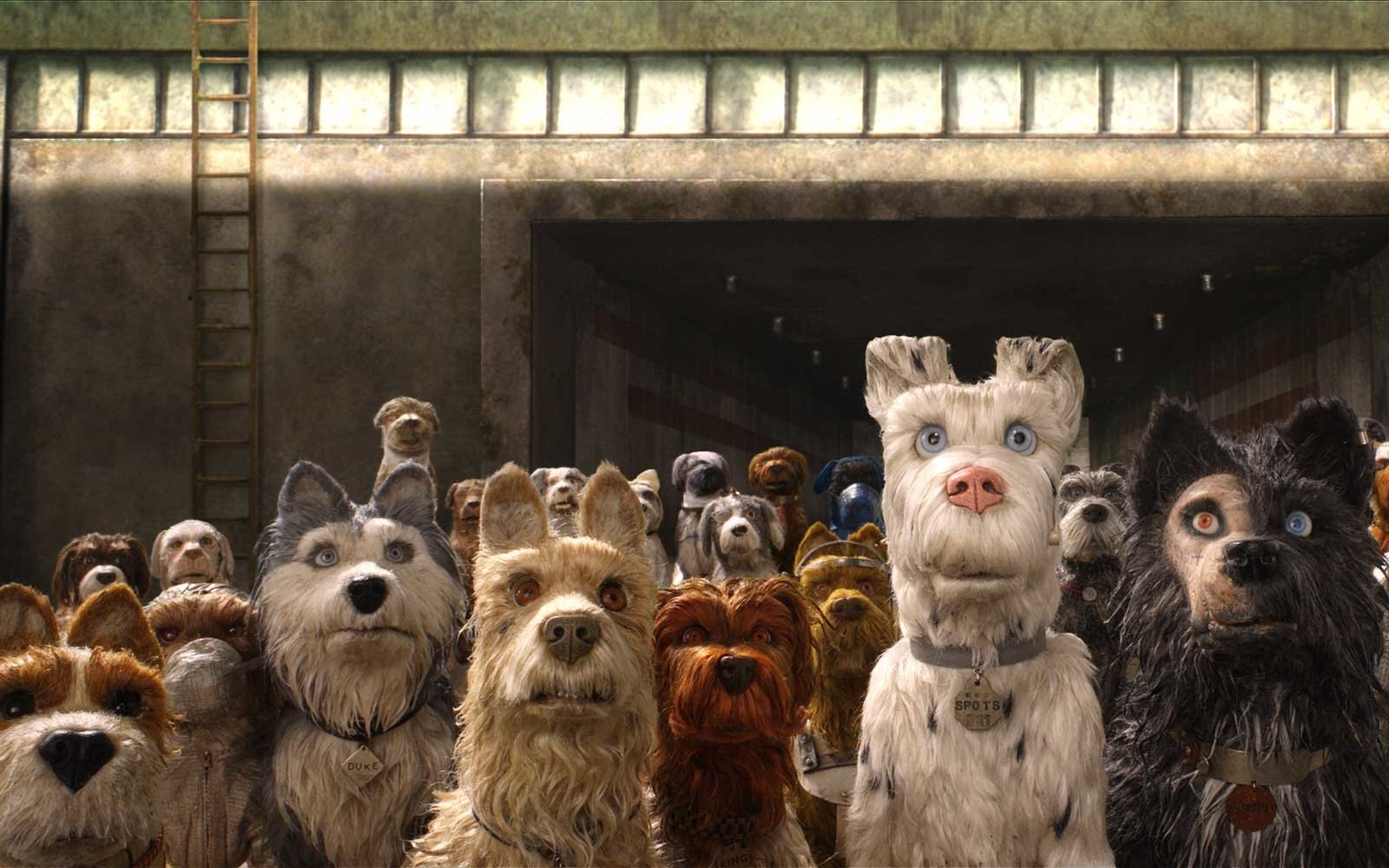Isle of Dogs (2018, Wes Anderson):
Regardless of whether he’s feted by the Oscars (Grand Budapest Hotel) or dismissed as twee (a lot of his other work), Wes Anderson has always marched to his own beat. With Isle of Dogs, the beat is that of taiko drums, as he flirts with japonaiserie. Animated in stuttery stop-motion style (picture the near-mournful solemnity of “Davey and Goliath” merged with the zowie art direction of “Thunderbirds”) and liberally stealing Japanese pop-cinema tropes, Isle of Dogs might be a mutt of multiple influences, but there’s no mistaking the cockeyed sensibility behind it all. Where else will you find a film that includes the cast credit “Yoko Ono as Assistant Scientist Yoko Ono”?
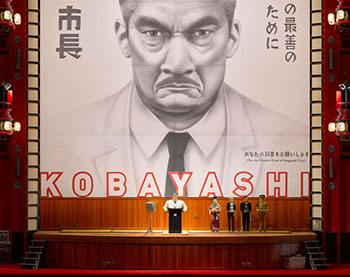 Animation suits Anderson; the medium matches his fussy, exacting aesthetic, and like his underrated Fantastic Mr. Fox (2009), Isle of Dogs is a non-stop parade of witty framing and inventive flourishes. The added influence of Japan (whose art can be just as compulsive and stylized as Anderson’s) is also a glove-tight fit — in place of Rushmore-style stage curtains, shoji screens demarcate the action, with chapter titles such as “Boy Samurai and the Headless Ancestor.” The setting is near-future Nippon, and Megasaki City mayor Kobayashi (a dead ringer for Japanese acting legend Toshiro Mifune circa High and Low) has declared dogs canis non grata due to a mysterious outbreak of “snout fever.” All pooches, housebroken or otherwise, are to be banished to an offshore garbage dump known as Trash Island — but are Kobayashi and his cronies responsible for the outbreak? And what’s with the cats constantly at the ruling party’s side, nodding in approval at every move?
Animation suits Anderson; the medium matches his fussy, exacting aesthetic, and like his underrated Fantastic Mr. Fox (2009), Isle of Dogs is a non-stop parade of witty framing and inventive flourishes. The added influence of Japan (whose art can be just as compulsive and stylized as Anderson’s) is also a glove-tight fit — in place of Rushmore-style stage curtains, shoji screens demarcate the action, with chapter titles such as “Boy Samurai and the Headless Ancestor.” The setting is near-future Nippon, and Megasaki City mayor Kobayashi (a dead ringer for Japanese acting legend Toshiro Mifune circa High and Low) has declared dogs canis non grata due to a mysterious outbreak of “snout fever.” All pooches, housebroken or otherwise, are to be banished to an offshore garbage dump known as Trash Island — but are Kobayashi and his cronies responsible for the outbreak? And what’s with the cats constantly at the ruling party’s side, nodding in approval at every move?
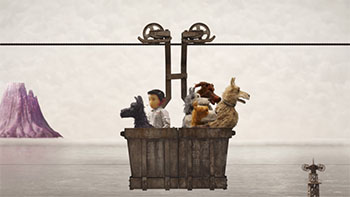 Meanwhile, the mayor’s intrepid ward Atari (voiced by Koyu Rankin) has gone rogue to rescue his beloved dog Spots (Liev Schreiber). When he crash-lands on Trash Island, he’s greeted by a motley band of abandoned dogs (voiced by Anderson stalwarts Ed Norton, Bill Murray, Jeff Goldblum and Bob Balaban — “All barks have been rendered in English,” we’re informed up front by narrator Courtney Vance), along with one ringer: Chief (Bryan Cranston), who’s never had a human home or a need for niceties. The ultimate canine rebel, he simply declares: “I don’t sit.” Before you can say “Hidden Fortress,” the dogs resolve to help Atari find his companion and expose Kobayashi’s perfidy, as they race against time to forestall a Final Solution which will eradicate all dogs in the prefecture for good.
Meanwhile, the mayor’s intrepid ward Atari (voiced by Koyu Rankin) has gone rogue to rescue his beloved dog Spots (Liev Schreiber). When he crash-lands on Trash Island, he’s greeted by a motley band of abandoned dogs (voiced by Anderson stalwarts Ed Norton, Bill Murray, Jeff Goldblum and Bob Balaban — “All barks have been rendered in English,” we’re informed up front by narrator Courtney Vance), along with one ringer: Chief (Bryan Cranston), who’s never had a human home or a need for niceties. The ultimate canine rebel, he simply declares: “I don’t sit.” Before you can say “Hidden Fortress,” the dogs resolve to help Atari find his companion and expose Kobayashi’s perfidy, as they race against time to forestall a Final Solution which will eradicate all dogs in the prefecture for good.
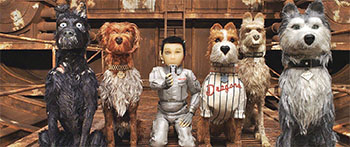 As a plot framework to support all manner of whimsy, Isle of Dogs is serviceable enough. The dazzle, as you’d expect of Anderson’s work, is in the details. He may have the overactive imagination of an eight-year old, but he stage-manages his productions with the discipline of an old master. The artwork alone contains more wit than the entirety of most movies, as we’re paraded through striking environments — apocalyptic heaps of garbage and processing plants, day-glo dojos, cavernous public halls, blood-red skies and jet-black city nights. Imagining a Japan bristling with space-age tech (antennas sprout everywhere, including from Atari’s head after his initial crash) yet anchored by old-school concepts of honor (the evocations of Akira Kurosawa are numerous, down to the big-boss horns on the soundtrack), Anderson regards his premise and furry friends with stoic cheekiness. When the fur literally flies between the dogs and their human oppressors, their brawls are a cartoonish yet somehow Zen-like cloud of random shadows and limbs. Much may be theoretically at stake, but the movie is at its best when it wanders off like a bored family pet, following its own caprices. Indeed, the two best moments are off-the-cuff bits where we bear intimate witness to the making of a sushi meal and transplant surgery, both operations equally whimsical and queasy.
As a plot framework to support all manner of whimsy, Isle of Dogs is serviceable enough. The dazzle, as you’d expect of Anderson’s work, is in the details. He may have the overactive imagination of an eight-year old, but he stage-manages his productions with the discipline of an old master. The artwork alone contains more wit than the entirety of most movies, as we’re paraded through striking environments — apocalyptic heaps of garbage and processing plants, day-glo dojos, cavernous public halls, blood-red skies and jet-black city nights. Imagining a Japan bristling with space-age tech (antennas sprout everywhere, including from Atari’s head after his initial crash) yet anchored by old-school concepts of honor (the evocations of Akira Kurosawa are numerous, down to the big-boss horns on the soundtrack), Anderson regards his premise and furry friends with stoic cheekiness. When the fur literally flies between the dogs and their human oppressors, their brawls are a cartoonish yet somehow Zen-like cloud of random shadows and limbs. Much may be theoretically at stake, but the movie is at its best when it wanders off like a bored family pet, following its own caprices. Indeed, the two best moments are off-the-cuff bits where we bear intimate witness to the making of a sushi meal and transplant surgery, both operations equally whimsical and queasy.
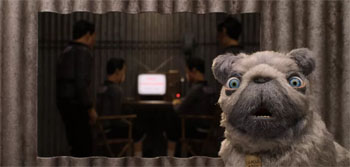 Though the subject matter is ripe for cutesiness, Anderson’s canine heroes are too hangdog (pardon the expression) to be precious. Even Nutmeg (Scarlett Johannson), the fleeting object of Chief’s affections, is none too flattered or flustered when he tells her he’s aware of her reputation as a show dog. “I don’t consider it my identity,” she breathily retorts. While Chief’s comrades don’t receive much development beyond what their human voice actors bring to the table (Norton’s Boy-Scout forthrightness, Murray’s deadpan fatalism), the character designs consistently charm, with the prize for most endearing mutt going to Oracle (Tilda Swinton), a soothsayer who picks up on her prophecies via local TV. Near-mute, locked in a dumbfounded stare, Oracle’s reactions have the zing of a silent comedy.
Though the subject matter is ripe for cutesiness, Anderson’s canine heroes are too hangdog (pardon the expression) to be precious. Even Nutmeg (Scarlett Johannson), the fleeting object of Chief’s affections, is none too flattered or flustered when he tells her he’s aware of her reputation as a show dog. “I don’t consider it my identity,” she breathily retorts. While Chief’s comrades don’t receive much development beyond what their human voice actors bring to the table (Norton’s Boy-Scout forthrightness, Murray’s deadpan fatalism), the character designs consistently charm, with the prize for most endearing mutt going to Oracle (Tilda Swinton), a soothsayer who picks up on her prophecies via local TV. Near-mute, locked in a dumbfounded stare, Oracle’s reactions have the zing of a silent comedy.
 Nutmeg: Will you help him, the little pilot?
Nutmeg: Will you help him, the little pilot?
Chief: Why should I?
Nutmeg: Because he’s a twelve year-old boy. Dogs love those.
Isle of Dogs heads towards a familiar resolution: the cynical Chief may fancy himself a lone wolf of a dog (“I’m a stray but aren’t we all?”), but it’s hard to resist the call of being man’s best friend and learning the value of loyalty as he becomes Atari’s new guardian. Still, Anderson can’t bring himself to focus on that; he’s too busy throwing in conspiracy subplots (Konnichiwa, Assistant Scientist Yoko Ono!), headsets that allow humans and dogs to bridge the communication gap, and a band of mutant cannibal dogs. Most jarringly, there’s bellicose American exchange student Tracy Walker (Greta Gehrwig), a freckled, gum-popping sleuth looking to blow the whistle on Kobayashi’s schemes. She also has a crush on Atari. How do we know this? Because she says so: “Atari Kobayashi, you heroically hijacked a Junior-Turbo Prop XJ750 and flew it to the island because of your dog. Darn it, I’ve got a crush on you.” Unfortunately, there’s more than one instance of that kind of on-the-nose dialogue, and it doesn’t play any better than it reads. Anderson has artistry to burn, but he has a habit of standing back and admiring his ideas rather than engaging with them; Isle of Dogs is an affectionate piece of cultural appropriation that’s an outline rather than a fully-formed work, and no amount of enticing flourishes can hide the hollowness at the movie’s core. (Ironically, this is one animated film that could have used more animation in the storytelling.) Just when we should be growing more involved with our heroes’ fates, the film loses focus down the stretch with a distended climax that’s more prosaic than exciting. While it’s easy to admire the idiosyncrasies and Anderson’s perfectly symmetrical tableaus, sometimes all you need is a five-second scene of a boy hugging a dog. The rest is just dressing, however painstakingly assembled.

